Tag: cataloging
What’s In a Name? How One Bancroft Library Archivist Shed Light on a Gold Rush Era Gem
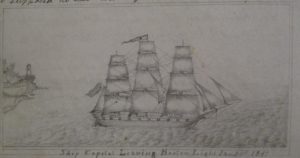
Background: Each year the Bancroft Library acquires a sizeable amount of new manuscript material. The sheer quantity of this material necessitates that the archivists who handle, process, and catalog these materials, exercise considerable judgment in balancing thorough and accurate descriptions that facilitate access with the need to make the materials available as quickly as possible. Archivists are trained to determine just the right level of description to allow for sufficient discovery. In the case of very large collections, an archivist rarely describes materials at the item-level.
But sometimes a single item merits closer examination and considerable research to render it truly accessible to the library’s researchers. One such item recently caught my attention–
The “Ship Capitol’s Log Book” is the account of a passenger aboard one of the first ships to head to California during the gold rush, arriving in San Francisco in July 1849.
At first glance, it looked like a typical gold rush era journal, with daily entries describing conditions and life aboard the ship as it made its way from Boston to San Francisco around Cape Horn. But this one stood out because it included several finely rendered pencil drawings throughout including ships, shorelines, and even an albatross at rest.
Unlike similar journals that have crossed my desk, this one came with a contemporary inscription inside the front cover identifying the ship and giving the date (and, incidentally, providing a neat title for the catalog record). The accompanying description provided by the vendor was also intriguing, noting that there was an additional inscription in a different hand: “Above this [title] is the inscription of Paul Maraspin, another passenger on the ship and the ancestor of the log’s most recent owner…. It is not clear who authored the journal.” However, upon closer examination, I determined that this might not be the case. It was clearly two initials followed by “Maraspin” but it didn’t look like either a “P” or “Paul.” I could not clearly make out the first initial, but the second one looked like an “L,” and below that a street address of “17 Court Street, Boston” and the date “Feb. 1917.”
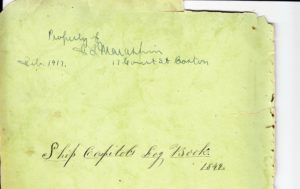
The vendor also noted that the lettering of the captions of the drawings was in a third hand, suggesting that someone other than the author of the journal might be the source of those. Also noted was the composer of several songs recorded in the journal, B.F. Whittemore.
The clues from the vendor and my own initial assessment of the journal suggested that a bit more research might make the journal infinitely more discoverable and useful. I became intrigued by the name of the owner of the journal, and the information suggested by the vendor just didn’t seem to fit with the facts the artifact was presenting to me.
Archivists have at their disposal the same research tools many other people do…the internet and access to genealogical sites that hold various records. There is a tremendous amount of information out there that makes this kind of research much more efficient than it used to be. Of course, too much information can also be problematic and it is the skillful researcher who can quickly sort through large amounts information and surmise whether more research will yield tangible results or, lacking that, have to call the effort “good enough.”
In this particular case, I discovered information about the owner’s signature that led to the solution of numerous puzzles presented by the journal itself, including how he came into possession of it, its likely author, the identity of the illustrator, the history of the lyricist of several songs, the author of the final song in the journal, and the history of the ship and its captain, Thorndike Procter.
Because Maraspin struck me as an unusual name, my first step was a Google search on the name. This resulted in the discovery of a Maraspin Creek in Barnstable, Massachusetts. Assuming the creek was named after a prominent family in the area, the information gave me hope that I could find out more about them and explore those connections.
I switched over to Ancestry.com to do a direct search on Paul Maraspin from Barnstable, Massachusetts around the time period of 1849. Numerous records surfaced that indicated a Paul Maraspin from Barnstable had been married and had several daughters, but none of whose initials matched the inscription in the journal. But then I found an application to the Sons of the American Revolution from 1937 for Paul Maraspin that listed his wife, Mary Eliza Davis, and one child, a son, Francis Lothrop Maraspin. Paul Maraspin had this son rather late in life, at the age of 52, and some 16 years after he had sailed to California. Looking back at the inscription, I could see now that the autograph was, in fact, “F.L. Maraspin.”
I then turned to confirming that this was, indeed, the Francis Lothrop Maraspin in the application form. Back to Google, I found an article from the Cape Cod Times lauding a Francis Maraspin’s 100th birthday in 1966. Back to Ancestry.com I found another Sons of the American Revolution application from 1935, this time for a Francis Lothrop Maraspin. I could see print coming through from the backside of the page and paged forward to see it. Right at the top was the statement identifying Paul Maraspin as his father. But the real clincher was at the bottom.The application was signed by Francis Lothrop Maraspin himself with his typed address, 17 Court Street, Boston.
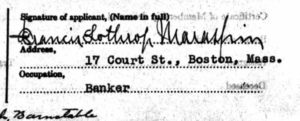
And from the journal again:

As you can see, the signature and address matched the inscription on the journal cover perfectly and we now knew we had our owner and could assume, with reasonable certainty, that the likely author of the journal was Francis Lothrop’s father, Paul Maraspin.
I shared these initial findings with my supervisor, Randal Brandt, who directed me to a publication that would be key to figuring out the rest of the puzzles. The Argonauts of California, published by C.W. Haskins in 1890, is an invaluable source of information about the gold seekers who came to California. The passenger lists it contains were crucial in figuring out the names of people associated with the journal. We now knew who had written the journal but who had done the drawings? And what about the composer of those numerous songs recorded in the journal? A closer examination of the drawings proved fruitful. Of the nine drawings, two of them had the initials “CCH” in the lower right hand corner.
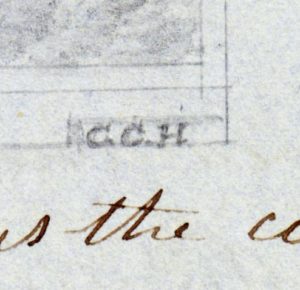
A quick perusal of the Capitol’s passenger list turned up only one possible match, a C.C. Hosmer. Now we knew the name of the illustrator. Back to Ancestry.com again, I went hunting for more information about him and found out his full name, Chester Cooley Hosmer (1823-1879). Because Chester Cooley Hosmer is also an unusual name, on a whim I Googled it along with the word “Capitol.” The very first result was a library catalog listing in the Special Collections of the Jones Library in Amherst, Massachusetts for Chester Cooley Hosmer’s journal documenting the same trip aboard the Capitol. Describing it as a journal “illustrated throughout with his drawings,” the catalog listing included scans of two pages with drawings. Here is one of them.
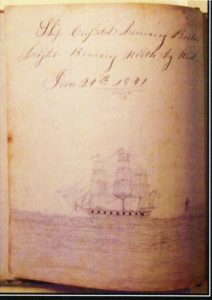
One can readily see the style of these drawings match those in the Maraspin journal. Not only did we now know our illustrator but also the location of his journal from the very same voyage.
Turning to the name listed as the songwriter, B.F. Whittemore (sometimes spelled incorrectly as “Whitmore” in passenger lists), a search turned up another interesting character. The Wikipedia entry for Benjamin Franklin Whittemore states that he went on to become a minister in the Union Army and then elected to the state legislature of South Carolina and eventually the House of Representatives.
Others identified in this process included the composer of the final song lyrics in the journal titled, “A Song Dedicated to the Officers of the Ship Capitol,” and signed “W.T. old friend.” Again, the passenger lists were the key as only one person had those initials, W.T. Hubbard.
More research on the ship and lists revealed the full name of the captain, Thorndike Procter of Salem, Massachusetts.
As might be true with any group of persons traveling so far from home for so long, there is inevitable tragedy as well as triumph. Captain Thorndike Procter committed suicide in San Francisco Bay on October 17, 1849. It was reported in the papers that the captain “had been lately subject to occasional fits of derangement, during the last of which he jumped overboard, and was drowned….” Nine weeks later, Paul Maraspin’s young “old friend,” William.T. Hubbard, just 23 years of age, also died by drowning in San Francisco Bay on Christmas Eve.
The work of improving access and discoverability to our collections is at the heart of what we do as library professionals. Unknown people become known, their stories and lives become real to us, and as you read this journal now you can see the intertwining of their lives. One hundred and sixty-eight years later, two journals from the same trip are virtually reunited because of the work of archivists and catalogers separated by time and a continent. In this way, library professionals contribute to a very large cultural jigsaw puzzle that, slowly but surely, becomes ever more complete.
To see the completed catalog record for this item please use this link:
http://oskicat.berkeley.edu/record=b23750637~S1
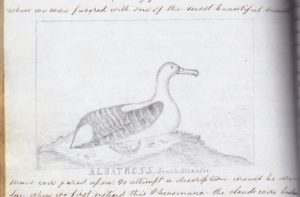
Introducing BadCat, the Catalog Record Help Desk
On Monday, August 23, 2010, the Catalog Department will implement the new process (see the July 21st blog entry: Catalog Record Help Desk – Internal Pilot) that will allow Library staff to submit catalog record problems via a web form that will feed into the FootPrints ticket system. Each FootPrints ticket will be distributed to an appropriate cataloger for resolution.
The name ?BadCat? was chosen through a Catalog Department vote, and may be defined as follows:
BadCat 1. Errors in the Library?s catalog; 2. Slang: an acknowledgment of such errors, as in ?Yeah, that’s my bad.? 3. Slang: ?cool, excellent person?; 4. Homage to Michael Jackson song about proving one’s toughness: ?Who’s bad?? 5. An epithet directed at a misbehaving cat or catalog.
The BadCat form will be accessible via the OskiCat Help Portal link on the Library Web Staff page.
Clicking on the OskiCat Help Portal link will take you to a page that contains links to forms used to report problems with electronic resources, Millennium problems and OskiCat issues, and beginning Monday, a link to BadCat: Catalog Record Help Desk.
Another option for accessing BadCat to report catalog record problems will be through the Staff View of OskiCat. Once BadCat has gone live, log in to MyOskiCat, search for a record, and then use the “Report a Problem” link at the top of the page.
Note: Unfortunately, there is no mechanism, at this time, for feeding information from the Millennium client directly into the BadCat catalog record help desk form.
The Systems Office will put BadCat into service this coming Monday, August 23rd. On Monday please wait to report any catalog record problems until you receive an email notifying Allusers that the system is ready.
Bernie 8/20/10
Catalog Record Help Desk: BadCat Coming Along Swell
After two months of BadCat going into production, we?re happy to say the project is experiencing success.
If you recall, during the pilot phase (July 21-August 20), Cataloging staff worked on old ?DCU? maintenance requests. During this phase, more than half of these back-logged requests were resolved. The remaining ?DCU? requests are being slowly incorporated into the ongoing current BadCat workflow.
Of the current BadCat workflow, more than 85% of new tickets are resolved within 2-5 days. Waiting for additional information from the ticket submitter is the primary reason other tickets take longer to resolve.
Tips for efficient maintenance requests:
· Use the BadCat form that’s linked from the OskiCat Help Portal on the Staff Web homepage.
? do not send maintenance requests to individual catalogers as this will only delay your request.
? Take advantage of using the auto-fill feature via MyOskiCat. See the BadCat FAQ for more details. http://sunsite3.berkeley.edu/wikis/TechServices/index.php?n=Main.EverythingAZ?action=download&upname=BadCatFAQ.pdf
· Respond in a timely fashion when asked for additional information or for material relating to your BadCat request.
· Do not use the BadCat form to request purchase, cataloging, access assistance, or URL correction for electronic resources. These should be submitted to the Eproblem Report Form that’s linked from the Staff Web homepage.
BadCat Stats:
Average number of tickets received per week: 27
Number of tickets closed in past 12 weeks: 372
Number of active tickets: 72
How are we doing?
The Catalog Department encourages you to tell us about your experience using BadCat. Please add a comment (or a question) to this posting, or send an email to Lisa Rowlison de Ortiz, lrowliso@library.berkeley.edu
SCP Monthly Update – 09/13
SCP Monthly Update
September 2013
[from Adolfo Tarango]
It appears that CDL will be moving forward with a DDA pilot with YBP/Ebrary. Therefore, SCP expects to start distributing OCLC records for these DDA titles sometime in the next several weeks. The records will be distributed with our regular distributions and the records will include the 793 hook ?UC Ebrary DDA pilot.? The estimate is that the first distribution will number about 2,400 titles and that subsequent distributions will number about a dozen per week. We found OCLC records for every title from the sample of titles provided by YBP; however, if this pattern doesn?t hold true for the actual title set selected, we will create brief level ?3? records for those titles not found in OCLC. SCP will attach each subscribing campus? XXXER holding symbol so the titles will show as being held the campuses. At the point of purchase, SCP will review the cataloging, enhance the records as needed, and redistribute records as updates. The redistributed records should overlay the previously distributed DDA records and will have a new 793 title hook ?Ebrary online monographs.?
Due to various problems with the first set of Airiti DDA vendor records the campuses retrieved, subscribing campuses will need to delete that set of records when the next set of records are made available from Airiti. Full instructions will be distributed to the subscribing campuses at the appropriate time.
Naxos has grouped its jazz recordings into a separate package. CDL staff fixed the immediate linking problem on September 20th. SCP will work on retagging and then redistributing the titles moved into the Naxos Jazz collection. The Naxos Jazz collection records will have a new 793 hook, ?Naxos music library online audio $p Jazz.? Note, while Naxos is calling this a jazz collection, it appears that the criteria for what they are including in the collection is somewhat loose. We have found non-jazz titles included and have found jazz titles left in the original collection. However, if you find a link that resolves to the wrong collection, please let us know.
The JSC approved title level cataloging for the journals in Gale?s Literature Resources Center. There are about 500 titles currently available and you should expect these titles to start showing up in your catalogs in the coming month.
The DDA pilots have become of some import and I?ve been asked to call them out specifically in our monthly updates. As of this writing we have two active DDA pilots. The CRC Press ENGnetBASE DDA currently contains 179 titles. SCP checks for and adds any new titles on a weekly basis. The Airiti DDA now includes 431 titles. Airiti, the vendor, will make records for newly added titles available on a monthly basis.
Last month we distributed the first set of journal titles from NOW Publisher, 23 of them. Other significant serial distributions were for China Online Journals (64 titles), Open Access (52 titles), China Academic Journals (38 titles), and SuperStar (32 titles). The major monograph distributions were for the NBER Working Papers (1617 titles), Karger (620 titles), Springer (296 titles), SuperStar (177 titles), Safari (135 titles), Wiley (103 titles), CRC Press (96 titles), and IEEE (83 titles). Two new monographic packages were added last month. The Synthesis Collection 5 (32 titles), from Morgan & Claypool, expands our selection of engineering and computer science monographs from this publisher. Literature Online added a set of audio recordings of Shakespearean plays (38 titles). The performers include actors trained at the Royal Shakespeare Company such as Joseph Fiennes and Sir John Gielgud. The recordings apparently include the appropriate sound effects and music, so make a date and listen to Anthony and Cleopatra. I hear that story has a happy ending.
Collection Services Annual Report fy 2013
The Collection Services Annual Report 2013 is now available.
From the Introduction
Fiscal year 2012-13 was a busy and productive year for Berkeley collections, made possible by the hard work of the the staff and librarians in CS units, Acquisitions, Cataloging, Licensing, Preservation, and by the Collection Services Council, the Collections Budget Group, the Scholarly Communication Advisory Group, and the Cataloging and Metadata Council.
We’d also like to thank the Library Applications & Programming staff, without whom many projects and proposals could not be realized; the Subject Councils for responding to requests for feedback on a wide variety of complicated and important issues; and to library selectors for managing their funds wisely, for timely responses to requests for information in support of licensing negotiations, and for their dedication to building the best collections possible for the UC Berkeley community.
Be sure to follow you particular curiosities in Appendix 1: Acquisitions, Appendix 2: Cataloging, Appendix 3: Preservation, Appendix 4: Collection Development & Scholarly Communication, and Appendix 5: CSC participation on groups outside CSC.
Cataloging single open access titles
Thanks to some sleuthing by Dana, David E. and Nga, a mystery has been unraveled. According to SCP:
“To request the cataloging of a single open access title not part of any specific collection send the request via the CDL Help Desk (helpline@cdlib.org). Provide the URL for the resource and a statement requesting SCP cataloging. Note, these “unreviewed” cataloging requests are of lowest cataloging priority and will be done as resources are available.”
SCP Update – June 2013
June’s Shared Cataloging Program (SCP) monthly update is now available. Lots of OA titles plus JSTOR, EBSCO and more.
SCP Update
Hightlights from the most recent SCP Update: 2731 titles from Springer , 309 from Wiley, and 126 open access titles. Read more at SCP Update – May 2013.
Collection Services – Easier to find help and to make requests
Over the last few months, several projects have been sponsored by Collection Services Council, and I’m happy to announce that all the pieces have come together. The goal has been, as always, to make it as easy as possible for selectors to find information they need and to know who to contact for specific requests. Here’s what’s new:
- A process has been established to get freely available and open access material cataloged; this is for those items that do not fill the criteria set for cataloging by SCP (CDL’s shared cataloging program)
- Three forms have been merged into one: e-order, Materials Acquired Digitally (MAD), and request for cataloging of freely available/open access items (new feature).
- Communications between selectors and staff in Acquisitions and Cataloging often involves transmitting the right pieces of data; a new “decision tree” has been devised that walks a selector to the right questions/answers for the case in hand. (Note: the e-problem form has also been redesigned and will become available soon.)
- The Collection Services staff-side website has been reorganized to take full advantage of the decision tree, allowing for a better organization of other documents that selectors have/will find useful.
In addition to the above, the Scholarly Communication Advisory Group also encouraged the development of a new set of pages designed to capture baseline information about scholarly communication that selectors should know.
A lot of people have been involved on working and implementation groups for these initiatives, including Bette Anton, Jim Church, Myrtis Cochran, Gail Ford, Kathleen Gallagher, Lynne Grigsby, Jianye He, Steve La Follette, Jean McKenzie, Sue Miller, Gary Mills, Nga Ong, Margaret Phillips, Claude Potts, Jane Rosario, Lisa Rowlison de Ortiz, Lisa Weber, and Susan Xue. My thanks to them all.
START AT the new website: http://www.lib.berkeley.edu/Staff/ CS/
- See the decision tree: (click on : “Make a Request/get help”)
- For the new forms: follow the decision tree for mono-electronic, serial- electronic, or database
- For the new Scholarly Comm site, pick Scholarly Communication
This was a lot to bring online simultaneously, so please be patient, and be sure to let us know what needs doing. Send comments, “can’t find it”, and other concerns to Gail who will find an expert and track the change.
–Bernie
SCP Update
“Some interesting developments and cancellations have kept” SCP “on [their toes] the last few months.” Among the new additions are a bunch of records for the ENGnetBASE DDA (demand driven acquistions) pilot. Also lots of Chinese-language cataloging. Read all about it in the latest SCP Update.